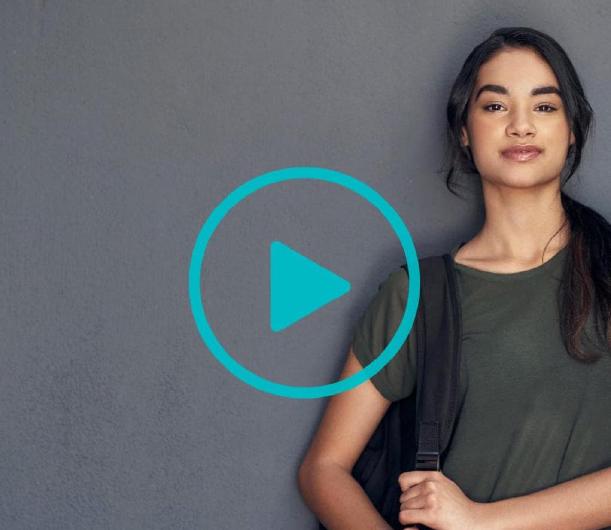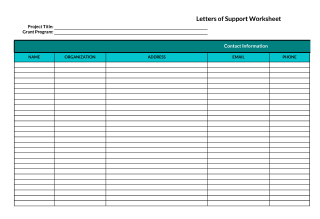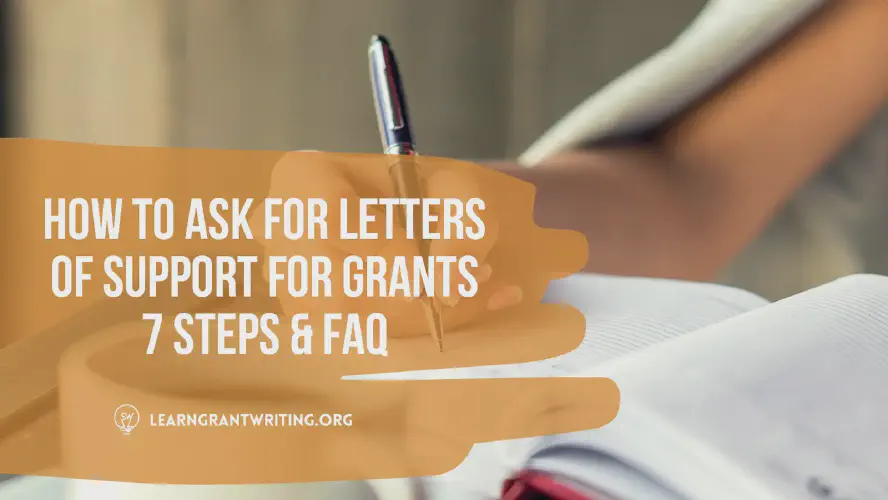When you apply for a grant for your nonprofit, you’ll usually encounter a question or section that asks for letters of support.
Maybe it’s your first time writing a grant proposal, and you’re having stressful flashbacks to asking for college letters of recommendation. Maybe you’re a seasoned grant writing pro who still breaks out in a sweat every time you hit this hurdle. 🎓😓
Trust us, we get it! Asking respected peers to take time out of their day and reflect on your organization and its work can certainly feel stressful.
Whether you’re a grants newbie or an old pro, we’ve got an easy 7-step method to help take the stress and complexity out of asking for letters of support.
Free Grant Writing Trainings
These how-to videos offer a smattering of webinar replays from our online grant writing training and feature topics such as working remotely, project management, fundraising, and how to utilize the Freedom of Information Act for federal funding.
Access Free Trainings
Quick Context: What are Letters of Support for Grant Applications?
First, let’s review some quick context about letters of support.
A letter of support is a written testimonial from a person or peer organization about your organization and its work. It should help back up the claims you make in your grant proposal, i.e., that you’ll be able to accomplish your plans and that they’ll have a positive impact. A letter of support gives funders a clearer sense of your organization’s connections, track record, and reputation in your community.
Think of a letter of support as an endorsement or highly personal review that a buddy organization or notable local partner writes for you. 📝
Strong letters of support can be powerful assets for your proposals, especially for smaller nonprofits looking to stand out to funders.
What’s the Purpose of a Letter of Support?
Funders have their own missions to pursue—responsibly making the most of their funds—and need to have faith in your abilities when they award you grants. Funders ask nonprofits for letters of support so they can learn more about your reputation and whether you’re an organization that really gets things done.
🔎 Plus, letters of support can give funders additional context that helps them make award decisions. These letters can help reveal a few things:
- What it’s like to work with your organization
- Whether you have active, engaged partners in the community who believe in your work
- The real-world impact of your organization’s work and past projects
Overall, letters of support lend you credibility, which is critically important when you’re asking a foundation or government office to entrust you with funding.
What Should a Letter of Support Include?
Letters of support can take many different forms, and funders may or may not provide specific guidelines for them.
In general, though, letters of support should contain a few essentials to ensure they’ll effectively represent your organization in its grant proposal. These include:
- Clear authorship and reputability. Somewhere in the letter, your writer should make it clear who they are, their relationship to your organization, and their authority to speak about your work together.
- A clear endorsement of your project. Your letter writer should explicitly indicate that they support your proposed project and not just your organization in general.
- Indications that your project aligns with funder priorities. Whether in a few clear mentions or a longer discussion, letters should reinforce that your project plans line up with the grant’s requirements and what the funder wants to accomplish with the grant.
- Mentions of your track record. Your letter writer should provide a few details about their past work with your organization that help to further illustrate your track record and the alignment of the proposed project.
Some nonprofits choose to provide their letter writers with “ghost letters” or prefilled templates to fill in for letters of support. We generally do not recommend this. However, whether you go this route or not, it’s still helpful to let your letter writers know about these elements and that they’ll help the letter make the best possible impact.
Who Should Write Letters of Support for Your Grants?
Anyone who can speak to your organization’s track record and who is in a position of authority in a relevant, reputable organization could be a strong candidate to write you a letter of support for a grant. Basically, you want someone whose words will carry some weight with the funder.
These individuals could include a variety of collaborators and partners. We’ll take a closer look and list potential candidates below as we walk through the steps for requesting a letter of support for a grant.
Free Grant Writing Trainings
These how-to videos offer a smattering of webinar replays from our online grant writing training and feature topics such as working remotely, project management, fundraising, and how to utilize the Freedom of Information Act for federal funding.
Access Free Trainings
How Do You Ask for Letters of Support? Our 7-Step Method
Here’s the 7-step approach we teach in the Global Grant Writers Collective™ on how to ask for genuine, inspirational letters of support that can nudge your application ahead of the rest. This method will help you build confidence and stay organized—a win-win as you gather valuable testimonials to make your pitch to funders. 🏆🏆

Step 1: Develop a Contact List.
Start by listing any and all organizations that would benefit from or will support your proposed project. Organize them into a handy contact list. We recommend tackling this step early, ideally before you host your grant kick-off meeting.
We provide a spreadsheet template in our online Grant Writing Training, but it’s something you can easily reproduce. At a minimum, your spreadsheet should include:
- Organization Name
- Contact Name
- Phone
- Columns for tracking if the letter has been sent and received

Letters of Support Spreadsheet
You can download a free spreadsheet template here. Remember to go File > Make a Copy or File > Download > Excel.
Google SheetWho Should You Ask for Letters of Support for Grants?
🌎 Seek support from as many disciplines and perspectives as you can. Casting a wide net can’t hurt! Try to build a list of 15-20 organizations.
For instance, when we seek letters of support for federal EPA grants, we collect them from neighborhood groups, environmental organizations like the Nature Conservancy, housing authorities, development organizations, professional associations, and other nonprofits.
By casting a net that wide, you can accomplish two things: 1) demonstrate broad support among unlikely collaborators (i.e., environmental groups and land developers), and 2) basically get 15 more pages of narrative content to help you produce a rich, credible proposal!
To get started, consider this list of typical organizations and individuals who nonprofits ask to write letters of support:
- Partner organizations that you currently work with or have in the past
- Constituents or clients who can attest to your on-the-ground impact
- Local government officials, spanning the full range from leaders of relevant local offices to your state’s congressional committee (for major federal grants)
- Other community leaders and influential stakeholders
- Current or previous funders, including foundations and major donors
- Local businesses that have publicly supported your work
What if I’m in a Rural Community and Don’t Have Many Connections?
Good question, but don’t limit yourself right off the bat!
No matter how small or isolated your community is, there are many organizations and neighboring communities that care about your project’s success. You can definitely identify 15 to 20 other organizations that would want to see you succeed, but you just may need to get creative.
Consider these options when you feel stumped:
- State departments focused on health and social services, the environment, and transportation
- Cultural organizations like museums, heritage centers, or art councils
- Neighboring communities
- Professional associations like AARP and their Livability program
- Job or skills training organizations and programs
- Regional and state colleges and educational programs
And if you’re writing a grant for a tribal community, consider a letter from your Village Corporation, Regional Corporation, and other regional organizations, for example, the Alaska Native Tribal Health Consortium.
Discover Grant Writing as a Career
If you’re interested in becoming a grant writing consultant, check out this free training on how you can pull off a meaningful career change.
Access Free Class
Step 2: Prep Your Request for Letters of Support.
Next, you’ll want to provide instructions on how to submit a letter of support to your nonprofit. Make it as easy as possible for your generous letter writers, and you’re likely to see more and better responses!
We also provide a template for letter requests in the Global Grant Writers Collective™, but here’s a quick summary:
- An overview of your organization and the name of the grant you’re pursuing
- A 1-2 sentence description of your proposed project
- A request for a letter of support from the organization you are inviting to respond
- Clear instructions for the letter writers, including:
- Use official organization letterhead.
- Address letters to whoever the grant guidelines specify (or your organization’s highest in command).
- Write a brief description of their organization as it applies to the project.
- Provide a statement explicitly confirming their support and, if applicable, information on how they will support the project during implementation.
- Describe any past collaborations between your organizations.
- A deadline for returning completed letters—we recommend 10-14 calendar days.
This structure provides a comfortable outline as a starting point while still allowing plenty of room in the "sandbox.” This will give letter writers the flexibility to add creative and personal anecdotes that will lend extra weight and richness to their endorsements.
Format your outlines as easy Google or Word Docs for your letter writers’ convenience.
Step 3: Assign Ownership of Contacts for Requesting Letters.
During the grant kick-off meeting, decide who will request which letters.
Generally, you want to match whoever has a personal or professional relationship within your organization with the other organization you’re seeking a letter from. For example, getting letters of support from people in senior roles requires some tact, and in many instances, the best way to get the letter is if the person highest in your organization (or as appropriate) requests it.
After deciding who will request which letter, update your spreadsheet with ownership details and provide your team with the information outlined in Step 2.
Next, let everyone know the best way to share your requests.
The outline document and your team’s explanations to your contacts should be concise. Remember, people tend to ignore or shy away from long emails. We’ve found the smoothest experience to be a quick phone call to the letter writer followed by a 2-3 sentence email that includes the outline document.
Step 4: Send Your Requests.
Send your requests for letters of support! Have your team update your central spreadsheet when they request a letter.
We much prefer this outline approach to providing pre-written or “ghost letters.” You’ll ultimately receive far more compelling, heartfelt, freeform letters than you’d produce with a template. Their authenticity will shine through—and funders will feel it, too! ✨
That said, some of your contacts may need a bit of a nudge…
Step 5: Provide Letter Templates if Needed.
Sometimes an organizational representative will ask that you ‘ghost’ or prepare them a letter that only requires their signature. This generally doesn’t happen with more than one or two letters.
Be prepared to write a templated letter that covers all the essentials discussed above. However, still try to highlight specific areas where they can add personalized content, like past collaborations. Every little bit of personalization will help.
Step 6: Immediately Save and Organize Your Letters of Support.
Immediately save letters in your project folder as you receive them, and mark them as received in your central spreadsheet. Nothing is worse than losing track of a letter (or worse, forgetting to include it!), because your inbox swallowed it.
Step 7: Compile All Your Letters of Support.
Once all letters have been received, compile them into a single tidy document. Consider including an attachment cover sheet that lists all organizations that provided letters. This helps the reviewer locate a specific letter and gives them a general overview of what to expect.
Next Steps
A stellar letter of support for a grant can accomplish a lot at once—satisfying funder requirements, making a positive impression, lending your organization credibility, and reinforcing your relationships with key partners.
By taking a proactive, organized approach, you can remove much of the stress from the process of requesting letters of support. Before you know it, you’ll have an overflowing stack of shining testimonials about why your organization is such an excellent choice for funding.
Serious about becoming a professional nonprofit or freelance grant writer? Learn about our comprehensive online grant writing training course.
Or, if you want to learn more about letters of support or any other common grant attachment, we encourage you to take our free grant writing course, download our free audiobook on the grant writing process, or keep exploring with these additional resources:
- How to Write a Grant Proposal: 7-Step System & Bonus Tips
- Grant Writing Tips for Nonprofits: 10 Ways to Start Strong
- Best AI Grant Writing Tools: 15+ Top Resources & Our Take
- 7 Superpowers of a Potential Grant Writer: How to Know Grant Writing Is for You
Free Grant Writing Trainings
These how-to videos offer a smattering of webinar replays from our online grant writing training and feature topics such as working remotely, project management, fundraising, and how to utilize the Freedom of Information Act for federal funding.
Access Free Trainings




